

Comparing MATLAB with Other OO Languages. Some Differences from C++ and Java Code The MATLAB® programming language differs from other object-oriented languages, such as C++ or Java® in some important ways.
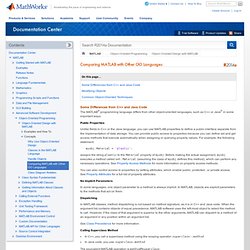
Public Properties Unlike fields in C++ or the Java language, you can use MATLAB properties to define a public interface separate from the implementation of data storage. You can provide public access to properties because you can define set and get access methods that execute automatically when assigning or querying property values. For example, the following statement: myobj.Material = 'plastic'; assigns the string plastic to the Material property of myobj. You can also control access to properties by setting attributes, which enable public, protected , or private access.
No Implicit Parameters In some languages, one object parameter to a method is always implicit. Dispatching In MATLAB classes, method dispatching is not based on method signature, as it is in C++ and Java code. See Class Precedence for more information. y = g(obj); Modeling Roles A practical series of Analysis Patterns. A practical series of Analysis Patterns by Francis G.
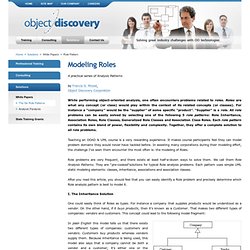
Mossé, Object Discovery Corporation While performing object-oriented analysis, one often encounters problems related to roles. Abstract Factory Pattern. Motivation Modularization is a big issue in today's programming.
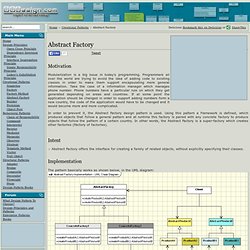
Factory Method Pattern. Motivation Also known as Virtual Constructor, the Factory Method is related to the idea on which libraries work: a library uses abstract classes for defining and maintaining relations between objects.
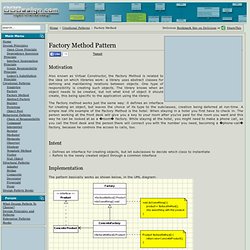
One type of responsibility is creating such objects. The library knows when an object needs to be created, but not what kind of object it should create, this being specific to the application using the library. The Factory method works just the same way: it defines an interface for creating an object, but leaves the choice of its type to the subclasses, creation being deferred at run-time. Modeling Roles A practical series of Analysis Patterns. Reference architecture. A reference architecture in the field of software architecture or enterprise architecture provides a template solution for an architecture for a particular domain.
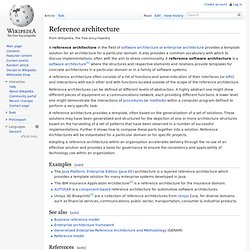
It also provides a common vocabulary with which to discuss implementations, often with the aim to stress commonality. Software architecture. Software architecture is the high level structure of a software system, the discipline of creating such structures, and the documentation of these structures.

4+1 architectural view model. Illustration of the 4+1 Architectural View Model. 4+1 is a view model designed by Philippe Kruchten for "describing the architecture of software-intensive systems, based on the use of multiple, concurrent views".[1] The views are used to describe the system from the viewpoint of different stakeholders, such as end-users, developers and project managers.
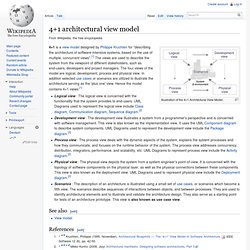
The four views of the model are logical, development, process and physical view. In addition selected use cases or scenarios are utilized to illustrate the architecture serving as the 'plus one' view. Hence the model contains 4+1 views:[1] Logical view : The logical view is concerned with the functionality that the system provides to end-users. See also[edit] Programming paradigm. A programming paradigm is a fundamental style of computer programming, a way of building the structure and elements of computer programs.
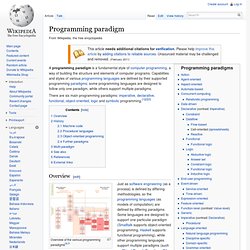
Capablities and styles of various programming languages are defined by their supported programming paradigms; some programming languages are designed to follow only one paradigm, while others support multiple paradigms. There are six main programming paradigms: imperative, declarative, functional, object-oriented, logic and symbolic programming.[1][2][3] Aspect-oriented programming. AOP includes programming methods and tools that support the modularization of concerns at the level of the source code, while "aspect-oriented software development" refers to a whole engineering discipline.

Logging exemplifies a crosscutting concern because a logging strategy necessarily affects every logged part of the system. Logging thereby crosscuts all logged classes and methods. History[edit] AOP has several direct antecedents A1 and A2:[1] reflection and metaobject protocols, subject-oriented programming, Composition Filters and Adaptive Programming.[2] Gregor Kiczales and colleagues at Xerox PARC developed the explicit concept of AOP, and followed this with the AspectJ AOP extension to Java.
The Microsoft Transaction Server is considered to be the first major application of AOP followed by Enterprise JavaBean.[3][4] Motivation and basic concepts[edit] Typically, an aspect is scattered or tangled as code, making it harder to understand and maintain. Join point models[edit] this(Point) Software design pattern. There are many types of design patterns, for instance Algorithm strategy patterns addressing concerns related to high-level strategies describing how to exploit application characteristics on a computing platform.Computational design patterns addressing concerns related to key computation identification.Execution patterns that address concerns related to supporting application execution, including strategies in executing streams of tasks and building blocks to support task synchronization.Implementation strategy patterns addressing concerns related to implementing source code to support program organization, andthe common data structures specific to parallel programming.Structural design patterns addressing concerns related to high-level structures of applications being developed.
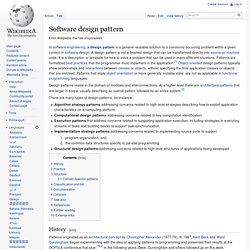
History[edit] Abstract factory pattern. A factory is the location of a concrete class in the code at which objects are constructed. The intent in employing the pattern is to insulate the creation of objects from their usage and to create families of related objects without having to depend on their concrete classes.[2] This allows for new derived types to be introduced with no change to the code that uses the base class. Software design. This article is about the activity between requirements and programming. For the broader meaning, see software development. Software design usually involves problem solving and planning a software solution. This includes both low-level component and algorithm design and high-level, architecture design.
Overview[edit] Software design can be considered as creating a solution to a problem in hand with available capabilities. When designing software, two important factors to consider are its security and usability.